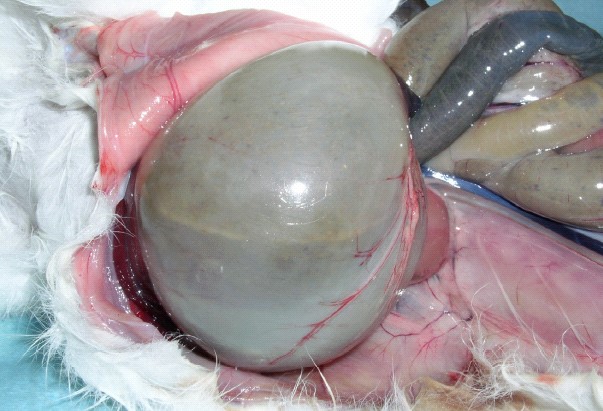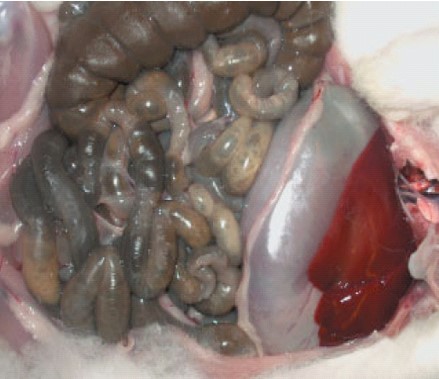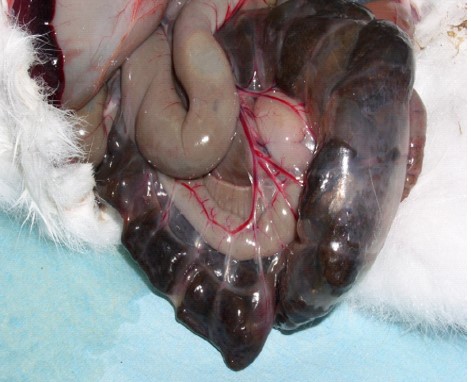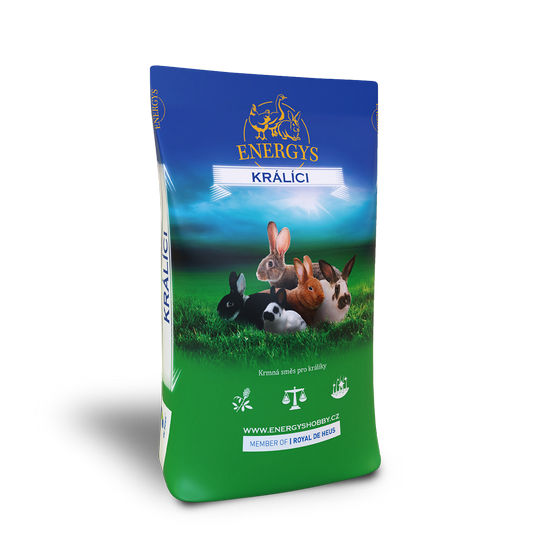Rabbits
Poultry
Laying hens
Quails
Guinea pigs
Pigs
Ostriches
Sheep and goats
Pigeons
Pheasants
Forest animals
Enterocolitis
Enterocolitis in rabbits is a disease detected for the first time in West France around 1996. The disease spread rapidly to other European countries during 1997 and 1998. Currently, it is present in 90-95% of farmed rabbit populations in various intensity of the manifested clinical symptoms.
The disease has peracute (very rapid) to acute progress and is associated with high mortality (30 – 80%). Reduced volume of consumed fodder tends to be the first symptom. This is followed by apathy and bloating. A small amount of watery diarrhea is one of the typical clinical symptoms. The fact that therapy with regular antibiotics is not effective is a major problem for breeders.
Weaned rabbits are the most frequently affected group (aged 6 to 14 weeks). However, breeding animals and sometimes even suckling kits suffer from this disease.
Initial assumptions of the cause
Naturally, similar to all diseases affecting the digestive tract, breeders initially looked for the cause in the fodder. Especially where farmed rabbits are fed exclusively complete feeding mixture, breeders believed that the composition, content of individual components or the premix composition causes this problem. Breeders and vets alike also looked for the cause of this disease in the content of mycotoxins, pesticides, etc. in the feeding mixture.
All of these hypotheses have been gradually eliminated. They have been disproven by successful experimental infection of healthy rabbits with contents of the digestive tract of dead or sick rabbits demonstrating the symptoms of enterocolitis. Only a contributory effect of the factors referred to above to enterocolitis is currently being considered.
Causes
It is a polyfactorial disease, which is probably caused by:
- viruses: Rotaviruses (group of viruses causing especially acute diarrheal diseases), Caliciviruses (small viruses causing diarrheal diseases), Parvoviruses (group of DNA viruses), Circoviruses;
- bacteria: E.coli, clostridium (group of gram positive anaerobic bacteria capable of creating spores to survive for example in soil for a long time. They commonly appear in the digestive tract of mammals), Klebsiella (bacteria causing inflammation and festering diseases), other enterobacteriaceae, streptococci);
- parasites: pasaralus, coccidia.
Other non-infectious factors also contribute to the illness and many of these can be influenced by breeders. These concern especially the hygiene of breeding, care for the animals and the quality of fodder.
Dissemination of the disease
The disease is transferred exclusively horizontally, via direct or indirect transfer, i.e.:
- by contact between healthy and sick animals (focal spread of the disease is often observed in farmed rabbit populations, when animals in neighboring pens contract the disease);
- contamination of cages, tools, feeders, etc.;
- breeder.
Clinical symptoms
a) primary – loss of appetite, apathy, stomach distension and bloating, constipation and mucus in feces can be observed gradually in sick animals;
b) secondary – diarrhea and death.
Pathological anatomical finding
Dissection confirms stasis (halt) of the bodily fluids in the stomach. Stomach tends to be filled with soft slushy matter with significant gas content.

The small and the large intestine is dilated (widened) and filled with gas. In 40-60% of cases, the intestines are filled with mucus. The mucous membrane is free of macroscopic changes.


Breeding measures
As with all diseases, the prevention of enterocolitis is also a prerequisite for all diseases!
Very important is the state of the animal’s immune system (proper vaccination against plague, myxomatosis, pasterelle). Perfect hygiene of breeding, disinfection of breeding equipment, feeders, crutch, etc. are necessary.
The origin of the disease also affects the quality and the way of feeding. In this context, it is necessary to emphasize regular feeding rather than in smaller doses, gradual feeding transitions and minimize feed changes. It is also very important to acidify the water to pH 4.2.
Literature and other sources used:
D. Licois, P. Coudert. Le point des recherches sur l’enterocolite épizootique du lapin. 8èmes journées de la recherche cunicole. Paris, 9-10juin 1999. Séance pathologie : Ed ITAVI 33-36
http://www.tours.inra.fr/urbase/internet/resultats/enterocolite/richard.htm
Related posts
10. April 2024
Keeping dwarf rabbits as pets is becoming increasingly popular. It does not require a lot of space and is ideal for people who live in smaller homes or apartments. Dwarf rabbits are also very friendly, so it’s no wonder that people are choosing them for this purpose more and more often. As with all animals,…
30. August 2022
In this article we will discuss several rabbit diseases – ear scab, tyzzer’s disease and heat stress.
24. August 2022
In this article we look at two diseases – e.Coli and enterocolitis.
2. August 2022
In this article we look at two common rabbit diseases, myxomatosis and infectious rhinitis.
13. July 2022
In the following article we will discuss rabbit plague – rhd or vhd (viral haemorrhagic disease of rabbits).
Related products

RABBIT DWART
Complete pelleted feed for dwarf rabbits with high digestibility. It contains a high proportion of fibre (high alfalfa and grass cake content) and a reduced sugar and starch content. Contains flaxseed, which has a positive effect on coat quality. Suitable for daily feeding. We recommend providing rabbits with safe fresh water and hay.

RABBIT CHAMPION
Feed for show rabbits, does not include Coccidiostat. A unique mix significantly supports the quality and growth of fur. Serve when moulting and at least two months before the start of the show season.

RABBIT GOLD FORTE
A premium feed mix in an ideal make up for gestating and breast feeding females. For the intensive fattening of rabbits for a period of up to 5 days before slaughter. It supports fast growth, meat content and an excellent state of health. It contains a coccidiostat which lowers the risk of mortality.

RABBIT KLASIK FORTE
Intended for the fattening of rabbits up to a point at least 5 days before slaughter. Suitable for attaining a high meat content and an excellent state of health. Thanks to its Coccidiostat content it lowers the animals mortality.

RABBIT KLASIK
For the final phase of rabbit fattening, a minimum of 5 days before slaughter. It supports high meat content and excellent taste qualities in rabbit meat. Without a coccidiostat.

RABBIT START
For young rabbits from the start of accepting feed to 4-6 weeks after weaning. The feed helps to significantly lower the death rate in the period around weaning. It contains a raised percentage of fibre and less starch. It does not contain a coccidiostat.
